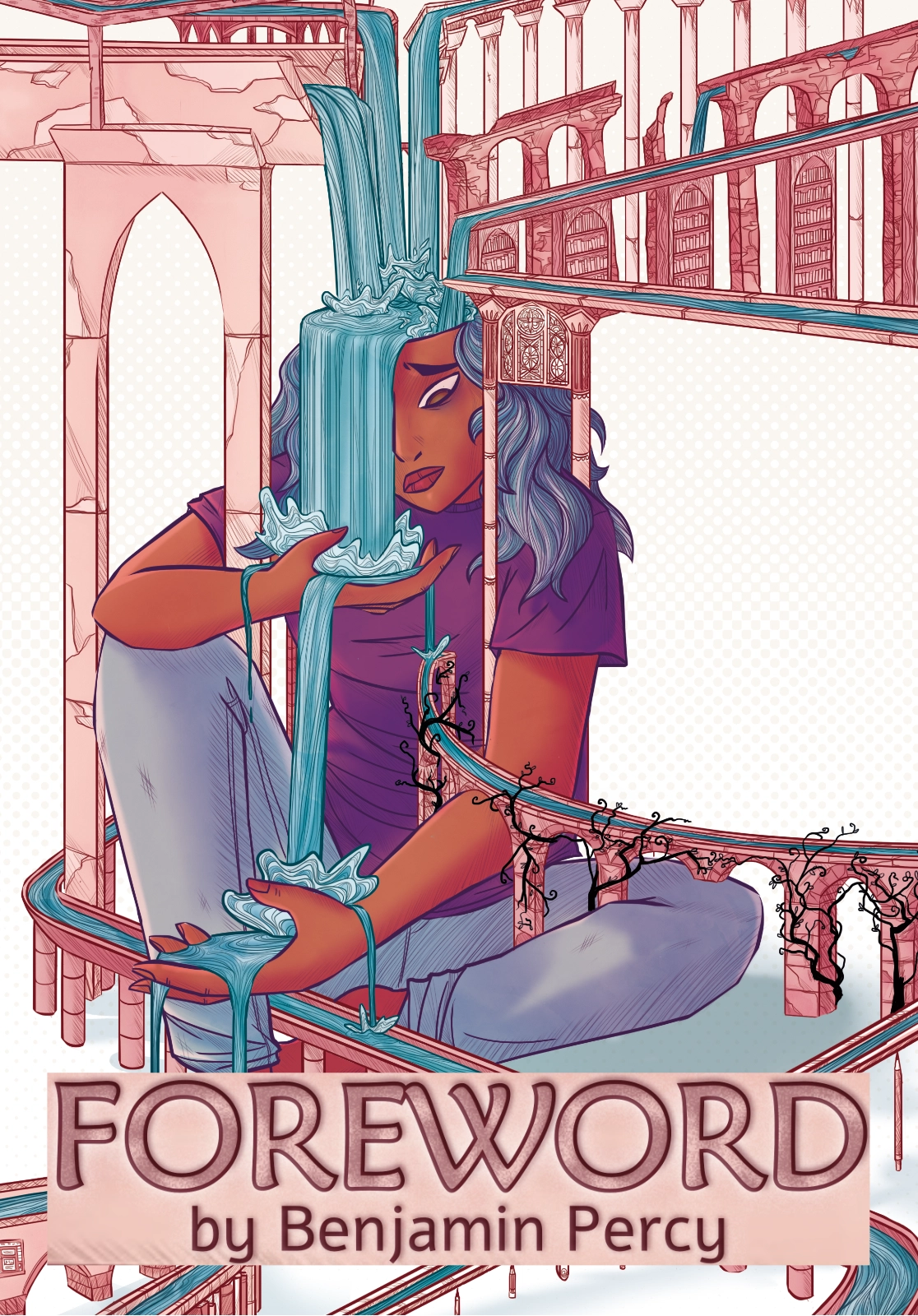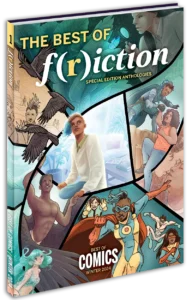
Foreword
Words By Benjamin Percy, Art By Sam Dow
You’re in a torchlit cave in France studying a hunting chronicle left behind by an Aurignacian who scratched the burnt end of a stick onto rock. You’re in the Met trying to decipher the hieroglyphs etched onto a slab of stone by Egyptians. You’re in a pew in Wisconsin ignoring the sermon and taking in the vivid, sun-soaked colors of the nativity of Christ pictured in the stained glass. You’re in a bathroom stall in Spokane trying not to laugh at the most profane mural of graffiti even as you uncap a pen to add your own cipher. You’re in a bar in Austin and a man with whiskey breath pulls up his sleeve and shows you a rippling slab of muscle coated in ink and tells you a story of grief that explains why he spent twenty hours getting needled. You’re in a nursing home in Boca Raton and your grandmother is flipping through scrapbooks and photo albums, telling you wandering stories about the ghosts of her past.
Businesses like to categorize (and subcategorize and sub-sub categorize) things, even our stories. A bookstore or a record store will send you in one direction for horror or metal, another direction for romance or country. Streaming apps will direct your scroll into peculiar strands like “Feel Good Food and Travel” or “Buddy Late Night Comedies.” Producers and editors worry over metrics and formulas and graphs. But our brains aren’t driven by algorithms. And most storytelling ignores taxonomy.
Comics embody this truth; they are a medium of defiance and rebellion. I’m not just talking about their niche or underground status. Or how, throughout their history, they have been a topic of moral panic and censorship, maligned by parents and politicians and the media. I’m also talking about the way they rebel against any strict form, flout boundaries, lean into experimentation, appeal to synesthesia.
They blend visual and textual literacy so that the navigation of the page can be driven by color or border or letter or line. If the sentences of a novel or memoir are laid out as cleanly and uniformly as rows of corn in a field, the pages of a comic surprise and even assault you with every page turn, as you take in the epic visuals of a splash page or tick, tick, tick your way through the boxes of a nine-panel grid or descend and ascend through five vertical columns. You’re constantly relearning how to process information—which makes you lean forward, which makes you arguably more engaged and complicit in the act of storytelling.
Sometimes, when I read a graphic novel or grab a monthly issue off the rack, I slowly digest each page, savoring and delighting in every detail. But sometimes I flip through to pleasure in the art alone. And (I say this as a writer) here is the humbling truth of comics. You can ignore every dialogue balloon and narration caption and still finish the story and comprehend it and think, now THAT was a hell of a comic book. The artist is the true director and wizard of the medium, in other words. This is one of the reasons comics are considered such an excellent teaching tool. The reader is decoding language, yes, but the setting, the time, the arc of the plot, the behavior and feelings of the characters can all be comprehended on some level through the art alone, making comics a vivid gateway drug to literacy. And from there, self-expression, conceptualizing new futures, rewriting the negative narratives that the world has told us about ourselves. Let’s drop more anthologies like this one into classrooms and libraries and prisons (and and and and) please.
Even if superheroes have been gobbled up by the Hollywood machine, comics are far from mainstream. Seeking out the single issues and trades and omnibus editions remains a cult activity, the brick-and-mortar comic book shops often secreted away in strip malls between the vape stores and tanning salons. The true believers might bag and board their issues or they might read them over and over and over until they fall to pieces in their hands, but these are holy texts. The cape-and-spandex canon of DC and Marvel is the gateway drug that leads you to the punk rock published by Image or Storm King or Vault. And those stories might lead you to local zines or internet showcases like Webtoons…
…or journals like F(r)iction. The name alone—a name that embodies defiance, a welcome discomfort— makes it clear that this is an ideal home for comics. And over the past few years they’ve been publishing some mind-melting work by boss-level creators. See for yourself. In these pages you’ll be assaulted by the hack-and-slash aesthetic of Carmen Maria Machado and Shan Bennion, you’ll be seduced into the sepia-toned nightmare of Ben Mehlos, you’ll be lost in the desert darkness and spectral wonder of Rebecca Roanhorse and Isabel Burke, and more, so much more, a catalog of some of the most exciting and challenging work that will widen your eyes and light up all your nerve endings and constantly surprise you.
